#Mona Saudi
Text

Mona Saudi (Jordanian, 1945), Untitled, 1973. Ink and coffee on paper, 26.5 x 26.5 cm.
106 notes
·
View notes
Text

From: شهادة الاطفال في زمن الحرب : رسوم اطفال الفلسطينين [In Time of War: Children Testify], Edited by Mona Saudi, Designed and hand-lettered by Vladimir Tamari, Co-published by the PFLP and «Mawaqif» (journal edited by Adonis and Mona Saudi), Beirut, 1970 [The Palestinian Museum, Birzeit]
#graphic design#art#drawing#book#cover#book cover#mona saudi#eid muhammad#vladimir tamari#adonis#mawaqif#popular front for the liberation of palestine#pflp#fplp#the palestinian museum#1960s#1970s
81 notes
·
View notes
Text
In the labyrinths of insomnia
I hear voices of silence.
— Mona Saudi, The Poetry of Arab Women: A Contemporary Anthology, transl by Kamal Boullata, (2001)
#Jordanian#Mona Saudi#The Poetry of Arab Women: A Contemporary Anthology#Kamal Boullata#(2001)#Essence
13 notes
·
View notes
Text

Mona Saudi, from Ghassan Kanafani's Complete Works, Vol. 1, 1972.
76 notes
·
View notes
Photo

“Through galaxies of stars and planets,” by Mona Saudi from Women of the Fertile Crescent: an anthology of modern poetry by Arab women (1978)
#Mona Saudi#Women of the Fertile Crescent : an anthology of modern poetry by Arab women#70s#poetry#arab literature
20 notes
·
View notes
Photo

Mona Saudi, Jordan, 1945-2022
Homage to Mahmoud Darwish-6-/تحية إلى محمود "Song to the Green"
1977
Silk screen and watercolour on paper
25 notes
·
View notes
Quote
Why don’t I write in the language of air? Master a new tongue with a different taste, a language that dances, that goes drunk through the streets, embraces trees, walks on water…that cries? A language that burns the world, and gathers autumn leaves?
Mona Saudi, tr. by Kamal Boullata, from I Grew Harder Than Tears,
4 notes
·
View notes
Text
by Giulio Meotti
There were shameful scenes at a Women's Rights Day demonstration in Munich's Marienplatz. Palestinian flags everywhere. Israeli flags were not welcome. Left-wing and pro-Palestinian groups insulted and pushed several Jewish women. Among the participants was the president of the Jewish community of Munich, Charlotte Knobloch (a Holocaust survivor).
Same scenes in Paris. Insults, attempted aggression, threats, and throwing of projectiles, the pro-Israeli collectives had to be exfiltrated from the Paris demonstration organized on the occasion of International Women's Rights Day. "We heard slogans like 'dirty Jews,' 'Nazis,' 'Israeli murderers,'" Mélanie Pauli-Geysse, president of No Silence, told Le Point.
No media or feminist organization in Europe is following the testimonies reported by the survivors of the family of Abu Bakr al Baghdadi, the caliph of Daesh.
Eggs, broken bottles, rubber bullets. "It was then that the situation worsened, we were only able to walk a few minutes before being exfiltrated by the police for our safety."
In L'Express, Sarah Barukh wrote: "There were Iranian, Afghan, Israeli, Pakistani, Yazidi, and others. We denounce the devastation of apartheid imposed by radical Islamism. We stand alongside women who are victims of barbaric traditions such as excision, in France and elsewhere." Next to her, Mona Jafarian, who fled from Iran, and Father Desbois, a Catholic priest who returned from Ukraine and recounted his life with Yazidi women, his arrest in Iraq, and his death sentence in several countries designated as lands of Islam because "I expressed words of sympathy towards the Jews."
Meanwhile, the Algerian writer Kamel Daoud writes that no media or feminist organization in Europe is following the testimonies reported by the survivors of the family of Abu Bakr al Baghdadi, the caliph of Daesh. His daughter, his wives, his sexual slaves are interviewed on Saudi TV to talk about the caliph.
"No relaunch in newspapers or platforms, no analysis, no echo," writes Daoud. "Western neo-feminism, crumbling into particularisms, is indifferent to this 'Muslim' scene where the condition of millions of women parades, beyond digital screens and the effects of ideological bubbles."
A forced tour should then be immediately organized to the Hamas cages under Gaza where Hamas is holding Israeli female hostages. And for those who don't feel like it, there is still the exhibition in London in which the conditions of imprisonment of the Israelis were recreated based on the testimonies of those who were exchanged in November.
Nothing seems to interfere with the ideological excitement these old and perverse peacocks derive from a barbarism they mistake for rebellion.
There is a pathological reluctance across the West to believe that Hamas has raped and mutilated women. "It didn't happen" or "where is the proof?" The speed with which these people went from saying "believe women" and #MeToo to "show the rape photos or it didn't happen" is mind-blowing.
Rape denial is so widespread that some have felt compelled to take to the streets to raise awareness of Hamas's sexual crimes. British Jews and their (few) allies gathered near BBC headquarters to say "rape is not resistance." Some wore jogging bottoms with stains between the legs, in solidarity with Naama Levy, the 19-year-old Israeli woman seen in that very state shortly after the Hamas pogrom.
The West went from "believe women" to "believe terrorists."
Nothing seems to interfere with the ideological excitement these old and perverse peacocks derive from a barbarism they mistake for rebellion in an unholy marriage of Western self-loathing and Islamic Jihad. They are willing to do anything to save the most squalid moral vanity and be able to continue selling us their "goodness." Except that it is really evil.
48 notes
·
View notes
Text
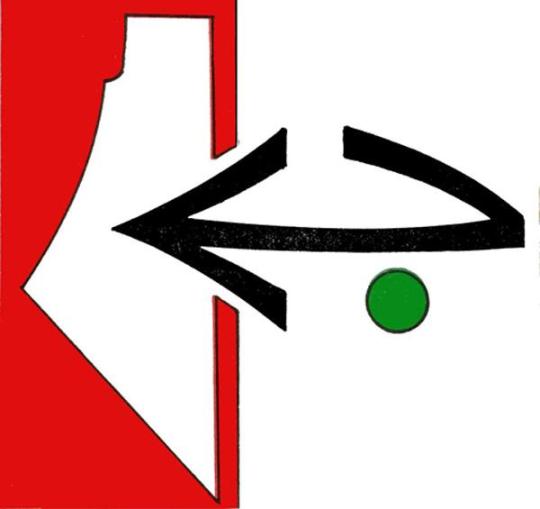
Origins of the PFLP Logo (source)
Analysis / Interpretation / Press
The Origins of the PFLP Logo
Berut, Lebanon - 1969
Vladimir Tamari - August 2016, Tokyo [speaking in the following text]
Following the overwhelming Arab defeat and the total occupation of Palestine, including Jerusalem in the Arab-Israeli War of June 1967, the Palestinians countered with a guerrilla war - the Resistance. I was in Beirut at the time, cut off from home and family, and working for UNRWA the United Nations Agency to support Palestinian refugees in the audio visual section. When our film group went to the Jordan river to film the stream of Palestinian refugees fleeing the war, I tried entering Palestine. I said "Salam" (Peace) to the lone Israeli soldier posted there on the bridge. He replied smiling "Shalom" but with his gun prevented my return to Jerusalem, my birthplace, and to Ramallah my home. Later in Beirut I worked in the UNRWA-UNESCO Institute of Education as an illustrator.
One day in early 1969 my friend X (who prefers anonymity) and I were wondering why the Resistance did not have an effective logo or symbol so we started designing one. This was a personal initiative as neither of us was or became members of any of the organizations carrying on the fight against the Israeli occupation of our beloved homeland. We sketched and played with various ideas – using the Arabic letter Fa for Falastin (Palestine), adding an arrow to the word Fath - Yasser Arafat's group, and finally adding a map of Palestine. The Fa + arrow + map made a simple dynamic symbol and I felt it was good enough to finalize and send to the PLO (Palestine Liberation Organization) as a logo suggestion. I have no idea if my covering letter and designs ever reached the poet Kamal Nasir, the spokesman of the PLO, or whether some committee there rejected a change (they already had a bureaucratic-looking logo designed by my friend the Palestinian painter Ismail Shammout. The military wing of the PLO had its own symbol, designed by the Syrian painter Nazir Nab'aa.)
Meanwhile as a graphic designer and typographer I was helping the Jordanian sculptor and poetess Mona Saudi produce her book In Time of War Children Testify of drawings and anecdotes by Palestinian refugee children from Baq'aa refugee camp in Jordan (Published in 1970 in Beirut jointly by the PFLP and Mawaqif, the journal of the Syrian poet Adonis, which Mona co-edited). I scripted the entire text of the book by hand using an early version of my AlQuds font. Mona had contacts with the PFLP, and had the idea to change the Fa of the logo to the Arabic letter Jeem for Jabha (Arabic: front). This I implemented using the distinctive curved letter jeem from AlQuds. Mona took the logo suggestion to Ghassan Kanafani, the spokesman for the PFLP. Kanafani, the famed Palestinian novelist, was also a gifted amateur artist and he immediately understood the impact of the symbol and had it adopted by the group, after changing the square format to a circle. People in the movement liked the logo and as the years and decades passed it appeared in all sorts of posters, flags, wall graffiti everywhere in and outside Palestine.
Needless to say, my having designed the logo did not mean I condoned what I soon felt were some serious mistakes made in the name of Palestine, such as the targeting of innocent civilians. In a spirit of disillusionment I left Beirut for good, and emigrated to Japan where I limited my activities for Palestine to designing posters, giving talks, and the like, devoting myself to my art and inventions. I had met both Kamal Nasir (the cousin of my brother-in-law) and Ghassan Kanafani. Once in Ramallah Kamal with his wonderful spirit, urged me to follow my dreams whatever the cost. Both he and Ghassan were assassinated by Israeli agents in Beirut, in 1972 and 1973 respectively. Their political work ended with their deaths, but their great novels and poems live on as a treasured part of the Palestinian cultural heritage. In 1976 my father obtained a permit to allow me and my family to visit him my mother and sisters in Ramallah then under Israeli occupation. On the bridge on the Jordan River I was arrested by the Israelis and detained in Jerualem for three days, where I was questioned about my above-mentioned activities then released. After three months I was not allowed to renew the permit to be in my own homeland and had to return to Tokyo.
The Arabic word Fath (Palestine Liberation Movement) with the arrow I designed. Feb 1969
X abbreviated the Fath to an 'F' with an Arrow, adding in Arabic "Towards Victory Always - Long Live Palestine!"
My drawing of the Fa + arrow March 1969
Brainstorming with X - the map is added. February 1969
The Fath logo sketch. Apri-May 1969
An early sketch of the PFLP symbol. May 1969
The final PFLP logo in outline. May 1969.
Printer's proof of the logo. Nov. 1969
Ghassan Kanafani, spokesman of the PFLP in his Beirut office around 1970 just as I remembered him. I went there on business related to the Palestinian refugee children's drawings book In Time of War, Children Testify. The finalized symbol is pinned on a map pf Palestine. To the left is the circular version which became the standard.
In 1970 I was asked to design this medallion or key-holder. 36 mm diameter.
A news item from AlHadaf the official PFLP magazine edited by Ghassan Kanafani. November 1969. "A NEW SYMBOL FOR THE POPULAR FRONT. The new symbol for the Popular Front of the Liberation of Palestine, as it appeared recently in a number of places. It consists of the letter 'J' ending with an arrow thrust forward, towards Palestine."
ABOUT HALF A CENTURY LATER, IN PALESTINE:
Now, 47 years after designing the PFLP symbol, the enthusiasm and wrath of those years is a distant memory. Nevertheless, the symbol itself is still very much in use as I discovered via a simple Internet search. The logo helps keep alive the spirit and hope of liberation, reminding us of the necessity of regaining our own homeland. It is still used at rallies attended by thousands, waved at funerals of those who have given up their lives to the cause - often as a result of mistreatment or hunger strikes in Israeli jails, and scrawled on the Separation Wall eating up our beloved Palestine from the inside.
Palestinian girls attend a Popular Front rally in Gaza in 2015. Note how they added a ^ mark to the symbol, for the letter Sheen in Shaabiyya- Popular. Right, the official symbol as it is distributed digitally from the group's website. My original outline of the logo have become slightly distorted, for example the horizontal line lost its subtle curvature.
A poster announcing the martyrdom of university student Saji Darwish shot by Israeli troops near Ramallah in Palestine in 2014 after a rock-throwing incident.
Saji's funeral procession.


28 notes
·
View notes
Text
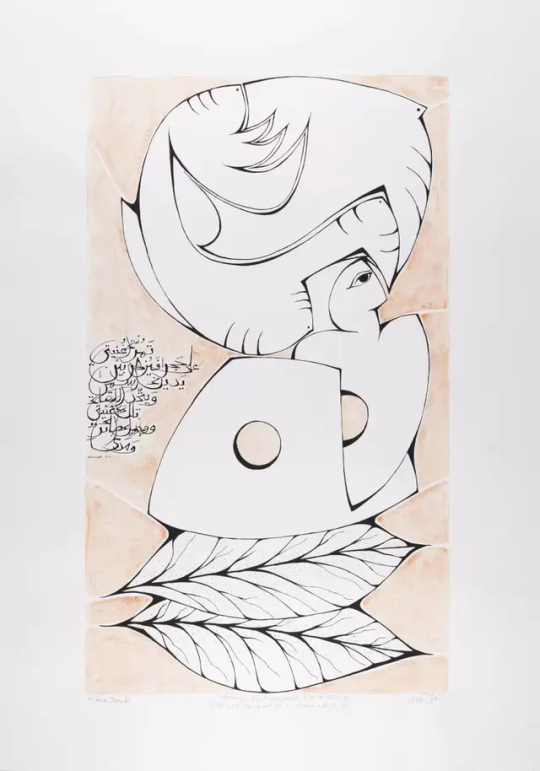
تحية إلى محمود درويش "تلك صورتها و هذا... العاشق / Homage to Mahmoud Darwish-4- "That's Her Image and This is the Lover's Suicide"
Mona Saudi, 1980, Silk screen and watercolour on paper
The Palestinian Museum Digital Archive
34 notes
·
View notes
Text
Why don’t I write in the language of air? Master a new tongue with a different taste, a language that dances, that goes drunk through the streets, embraces trees, walks on water… that cries? A language that burns the world, and gathers autumn leaves?
Mona Saudi - 'I Grew Harder Than Tears,' tr. by Kamal Boullata
7 notes
·
View notes
Note
oh also!! i was watching the saudi arabian gp and i went "oh my god! i'm ollie and mona's charles!!!!!" thank you so much for adopting me (lol) in the lestappen space <333
🥹 My own Ollie. ❤️
This is such a cute fucking compliment, thank you so much. Excuse me while I grin about this forever.
3 notes
·
View notes
Text

شهادة الاطفال في زمن الحرب : رسوم اطفال الفلسطينين [In Time of War: Children Testify], Edited by Mona Saudi, Designed and hand-lettered by Vladimir Tamari, Co-published by the PFLP and «Mawaqif» (journal edited by Adonis and Mona Saudi), Beirut, 1970 [The Palestinian Museum, Birzeit]
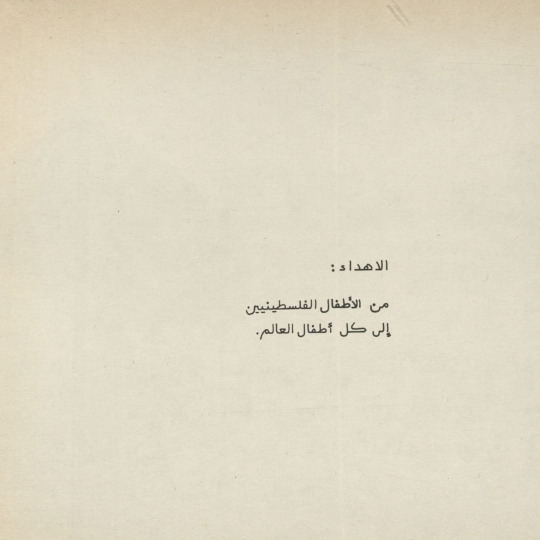
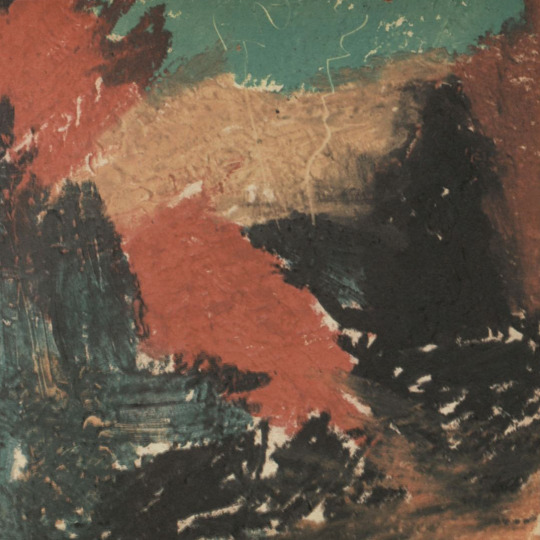



#graphic design#art#drawing#book#cover#book cover#mona saudi#eid muhammad#vladimir tamari#adonis#mawaqif#popular front for the liberation of palestine#pflp#fplp#the palestinian museum#1960s#1970s
55 notes
·
View notes
Text
The whole universe is reduced to […]
the tides of death and birth.
— Mona Saudi, The Poetry of Arab Women: A Contemporary Anthology, transl by Kamal Boullata, (2001)
15 notes
·
View notes
Text
Mona Saudi, "So drunk am I with the night, the air, and the trees" translated by Kamal Boullata.
"So drunk, I enfold the seas of forgetfulness.
When the shore appears, I bend away with my mast
towards the endlessness of the waters
counting the waves: wave by wave
I yell at the sea:
more of your remoteness.
Fortitude is futile, frustration and conversations
go on and on around the fireplace.
The days have numbers, the faces have names.
And the masks mime according to the time
recorded on the clock in the
piazza of the city.
Selling is a god. Buying is a god. And you,
they have abandoned you. They let you fall
into oblivion, yes, you:
the distant traveling of the unknown in the
darkness: the drunkenness of the night and the air.
So drunk am I with the night, the air, and the trees
I have carried you, Sea, upon my forehead
you that carry no name, the journey to the unseen
through you and in you, the whole
universe is reduced to the circles of the water:
the tides of death and birth
and the silence of the migrating birds
between the poles.
You, migrating birds:
go tell the shores you are reaching
the sea is coming to wash the cities
to sweep the masks that are numbered
according to the rites of the marketplace
(the bowing, the creeping, and the fear.)
The sea is coming with the verses of the
pregnant stones:
Action is the word and Refusal of the old.
The sea is coming. Open up the way
for the procession of The Sea.
May glory be to the god of The Sea.
There is no god but
that which is coming.
Coming with changes: illuminations
New crystallizations procreations through death
and birth.
Coming in the absent present
in the present absence
in a sweeping sea of circles."
2 notes
·
View notes
Text
Salvator Mundi - master of the dead eyes
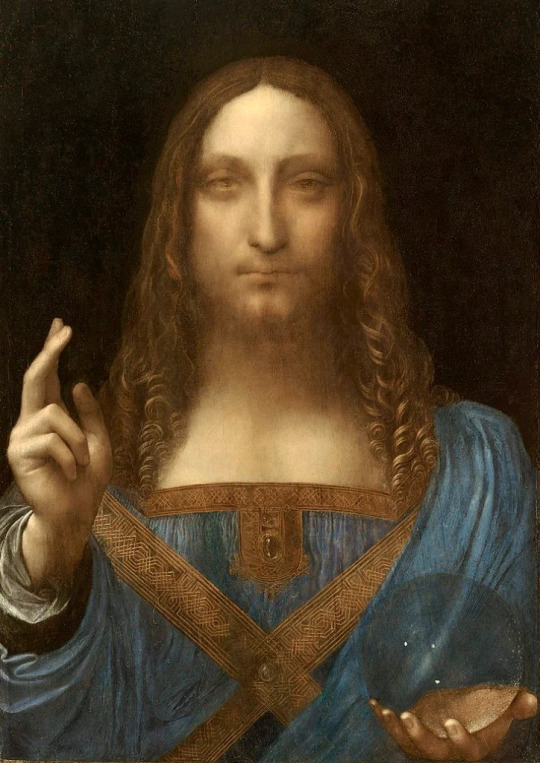
Salvator Mundi, various attributions (Louvre Abu Dhabi)
The Salvator Mundi painting, widely touted as a Leonardo, seems to have disappeared into the limbo of the Saudi Royal family’s treasury where it will doubtless lie, like an ingot of gold in a vault, unseen by most and unappreciated by its owner except as proof of the great wealth required to secure it. Frequent mention, however, is still made of this picture, and while that continues, so does the undesirable confusion that is spread by any demonstrable misattribution. This Brief Study is intended to provide that demonstration.

From left: Head of the Young John the Baptist (Drawing from a private collection, featured in an auction catalogue from 1934 as ‘School of Leonardo’) ; Salvator Mundi ; Head of a Woman (Musee du Louvre?)
Drawings, as always, are helpful. Here are two, to set beside the Salvator Mundi: on the left of it a drawing of a young John the Baptist, on the right a drawing of a young woman, possibly at the Louvre. It is enough to compare, and find similar, the eyes, the nose, the mouth, the treatment of hair. If likeness means anything, it ought to obtain in a juxtaposition such as this. As soon as it becomes clear that these two images are products of the same hand, it becomes clear also that the artist who made the drawing cannot be Leonardo, who never drew like this, and therefore Leonardo cannot be responsible for the painting either.
Of course the Salvator Mundi is Leonardesque. It is by an inferior artist (perhaps Salai, as once suggested by Suida) who has latched onto the ‘sfumato’, or smoky mysteriousness, that is displayed – for some tastes, to excess – in the late Leonardo Saint John the Baptist at the Louvre and copied by this artist in a painting at the Walters Museum. This mysteriousness, the smoky atmosphere implied in the etymology of the Italian word, is indulged in by this artist as if it was all that mattered in Leonardo’s art. The result is that Christ stares out at us, like a ghost from another world, with those strange, ‘dead’ eyes.

Left: St John the Baptist by the follower of Leonardo – Walters Museum, Baltimore ; right: Leonardo’s original – Musée du Louvre

Comparing the earlier drawing with the two paintings of John the Baptist
Comparing the earlier drawing with the two Baptist images either side, one by the copyist, the other by Leonardo, reveals as much as the difference in colour, the ‘Salvator’ eyes, nose and mouth.

Both attributed to the School of Leonardo, Left: ‘Head of a Youth’ – Ambrosiana, Milan ; Right: Portrait of a Lady – Columbia Museum of Art, South Carolina)
Another drawing , of an androgynous-looking youth at the Ambrosiana, shows the same rather long eyes whose lids are more prominent than anything between them . This might almost be a study for the no less ghostly Portrait of a Lady at Columbia Museum of Art in South Carolina. The same artist’s draughtsmanship (or lack of it) is seen in a drawing (Mona Vanna) and a painting both featuring a naked Mona Lisa. A weak sense of form is disguised by a quantity of perfunctory smudging of charcoal or graphite. His admiration for Leonardo is matched by his failure to understand how necessary a proper grounding in observational drawing was to Leonardo’s painted work. A similar failure attended the followers of Turner.

Left: Mona Vanna, attributed to Leonardo ; Right: Female Figure, attributed to Salai
If we return to the Salvator Mundi, we can observe the unconvincing treatment of drapery folds and the way in which ornamented braidwork is not adequately integrated with the rest of Christ’s robe, but lies across it in two, rather than three, dimensions. When our eye moves to the orb, it is equally dissatisfied by the lazy depiction of it, with no attempt at highlight. The orb is as dead as the eyes.

The draperies, braidwork and orb from Salvator Mundi tell us this is not Leonardo’s work
Colour is always a significant indicator in paintings. In this case we have a near-Prussian blue with chestnut browns trailing off into a deeper brown penumbra. This is the palette of the Lansdowne Madonna (‘Madonna of the Yardwinder’), a more impressive work than the Salvator Mundi but displaying a similar tendency to wrap figures in a haze of sfumato.

Left: The Lansdowne Madonna – Private Collection – features the same colour palette and ‘sfumato’ as the Salvator Mundi
Clearly I do not hold this artist in much esteem. Plutocrats are welcome to spend a fortune on his work, but the rest of us should keep our eyes peeled for quality and not allow our vision to be blurred by the ‘Leonardo mystique’ and the floaters of dubious attributions. What this case highlights, not for the first time, is the regrettable necessity for connoisseurs to apply themselves to mediocrities. In an ideal world they would not need to, but they often have to because one person – an originator whom others follow – has ascribed a work by an inferior artist to a vastly superior one. These words, inferior, superior, imply what is at stake: a difference of quality. The exercise I have conducted here will have some value if it succeeds in demonstrating that difference. A painter who has little sense of form cannot disguise the fact, try as he may, with ‘mystery’ that has no depth or substance; it is hollow and spectral, like the dead eyes. If we cannot definitely name him, let us nickname him the Master of the Dead Eyes.
#leonardo#leonardo da vinci#salvator mundi#connoisseurship#studies in connoisseurship#art history#attribution#painting#louvre
6 notes
·
View notes